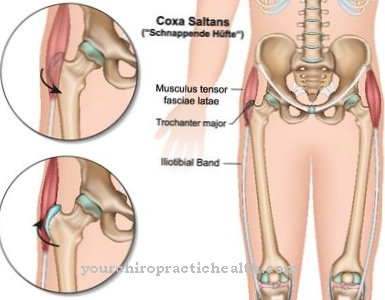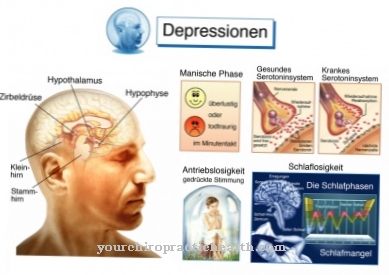Asbestosis can meet people who have dealt with asbestos in their professional life. This fiber has been widely used since the 19th century because of its excellent heat resistance and insulation properties, especially in the construction industry and for work clothing. Because of its harmful effects on health, the use of asbestos has been banned in Germany since 1993 and in the entire EU since 2005.
What is asbestosis?

© axepe - stock.adobe.com
Asbestosis is one of the so-called black lung diseases. It is caused by inhaling the smallest asbestos particles, the fiber dust. Asbestosis can still occur if the patient has not been exposed to the harmful substance for many years.
It can take 15 to 30 years for the disease to break out. The actual duration depends u. a. according to how intensively the patient was exposed to the damaging asbestos material and how long this was done.
causes
If asbestos dust is inhaled, the cells responsible for this in the lungs can neither completely decompose nor transport the fibers away, which is actually their job. The result is an accumulation of pollutants, which leads to what is known as fibrosis.
The term refers to an increase in the connective tissue in the lungs between the alveoli, which must remain mobile for breathing, and the blood vessels. Parts of the lungs become scarred and harden. The lower sections of the lungs are particularly affected. This means that you are no longer as flexible as before, and breathing becomes increasingly difficult.
As a consequence, there is usually shortness of breath. In addition, there is a strong, dry cough, often together with a thick sputum. Chest pain occurs when breathing. The patient's physical performance is limited.
You can find your medication here
➔ Medication for shortness of breath and lung problemsSymptoms, ailments & signs
Depending on its severity, asbestosis can cause various symptoms. Often years pass between exposure and the appearance of the first symptoms. Eventually, however, there is inflammation in the lung and pleural tissue, which is noticeable through various respiratory problems.
Most of those affected suffer from shortness of breath, dry cough and sputum, often associated with severe pain and increasing malaise. Hoarseness can also occur due to the asbestos lung or any secondary diseases such as lung or larynx cancer. The color of the voice changes significantly and the voice sounds increasingly brittle as the disease progresses.
Initially, the breathing difficulties mainly occur during physical exertion. Later on, problems also arise during periods of rest, and finally asbestosis becomes chronic. External signs of asbestos lung are the thickened finger ends, which resemble the shape of drumsticks.
The skin also turns bluish, especially on the fingers, lips and around the mouth. In later stages, asbestosis can lead to the development of tumors. Such degeneration of the cells manifests itself in shortness of breath, tenderness in the area of the lungs and other symptoms that depend on the location and size of the tumor.
Diagnosis & course
Since a very long time can pass between contact with asbestos and the appearance of the first symptoms, the connection between symptoms and illness is not always immediately recognizable. For the diagnosis by the specialist, it must therefore be clarified in a conversation whether the patient belongs to one of the occupational groups particularly at risk for lung diseases.
The symptoms are usually clearer when the general symptoms such as breathing difficulties are accompanied by a deteriorated general condition. In the process, the person concerned loses weight, becomes powerless, and can often no longer perform their daily tasks. During the physical examination, the doctor will listen to the lungs with a stethoscope. Fibrosis causes typical noises when breathing, described as crackling.
The lung function test shows to what extent the values are restricted and whether enough air is still being moved when breathing. Blood and urine samples can complete the diagnosis. An X-ray examination and computed tomography finally show where in the lungs there are fiber deposits. During a bronchoscopy, tissue samples can confirm whether the deposits are asbestos, i.e. whether asbestosis is present.
At an advanced stage, the disease usually leads to the disability of the patient. It can greatly promote the development of lung cancer.
Complications
Complications that arise as a result of asbestosis are almost independent of treatment or therapy, because there is currently no way of removing the fine crystal needles made of asbestos from the alveoli. The severity and type of complications arising from asbestosis depend almost exclusively on the cumulative inhaled quantity of asbestos needles.
The fact that the complications often only appear years after inhaling the asbestos dust has a somewhat fatal effect. Unfortunately, it is the immune system that tries to get the tiny mineral needles out of the lung tissue by activating macrophages. However, that doesn't work, so the macrophages then cause a problem and have to be cleared away by the immune system.
Through the chronic inflammatory processes that the immune system initiates and maintains, the functional lung tissue is replaced by collagenous, fibrous connective tissue, so that it loses its elasticity and functionality. Immune system reactions ultimately cause progressive pulmonary fibrosis.
The lung function is increasingly restricted, so that further complications such as shortness of breath, dry cough with sputum, visible cyanosis (blue discoloration) on fingers and lips result. The most serious complications that often develop from asbestosis are lung or larynx cancer. Both diseases are associated with a poor prognosis.
When should you go to the doctor?
Asbestosis is a fatal disease. This is triggered by inhaled asbestos particles. Asbestosis can only be recognized as an occupational disease through repeated visits to the doctor. The problem is that the disease only occurs decades after the asbestos contact and is then usually well advanced. The symptoms of asbestosis initially resemble those of chronic bronchitis. As a result, those affected usually go to the doctor much too late.
The symptoms of the onset of pulmonary fibrosis, asbestos-related cancer or mesothelioma offer only inadequate treatment options due to the long latency period. People who knowingly come into contact with asbestos at work should protect themselves appropriately. The asbestos dust lung is the long-term consequence of inhaling asbestos-containing particles.
As the second most common occupational disease in Germany, asbestos-related deaths occur again and again thanks to a lack of treatment options. The doctors consulted can only alleviate the suffering of their patients, but not cure them. A further increase in the number of cases is expected by 2020. Only then does the asbestos ban, enacted in 1993, take effect.
It is important to realize that people with other risk factors - especially smokers - are significantly more likely to develop asbestosis. Lung tumors in particular are the result. Pulmonologists are the doctors who are usually called in when the first symptoms arise. They usually cannot do much for the patient.
Doctors & therapists in your area
Treatment & Therapy
Asbestosis is incurable. The scarring of the lung tissue, once developed, cannot yet be reversed. Therapy therefore aims to prevent or at least slow down the progression of the disease and to alleviate the symptoms. Various methods are used for this.
Cortisone preparations are the ideal means to reduce inflammatory and allergic reactions in the organs. If the oxygen content of the blood falls below a certain limit value, long-term therapy with oxygen is advisable. The patient is supplied with oxygen for around 16 hours a day. The aim is to increase the level in the blood, to strengthen the patient and to enable them to cope better with everyday life.
Medicines that reduce the immune system's defense reactions, so-called immunosuppressants, can also slow down the course of the disease. Physiotherapy plays a particularly important role in treatment. Breathing exercises, relaxation techniques and an adapted, moderate sports program can alleviate the symptoms and improve the quality of life.
Nutritional advice can also improve your general condition significantly. Since smoking makes the disease much worse, a smoking cessation program is essential. In severe cases, a lung transplant can be useful.
Outlook & forecast
Asbestosis is one of the most dangerous black lung diseases that affect the airways. Inhaled asbestos fibers lodge permanently in the lungs. First, pulmonary fibrosis develops, later usually mesothelioma. Lung cancer and throat cancer are other consequences. All in all, this does not allow for a positive prognosis.
The asbestos exposure is assessed on the basis of inhaled fibers over a number of at least 25-30 "fiber years". The problem is that the disease often only occurs 30 years after occupational or otherwise acquired exposure to asbestos. Exposure to asbestos fibers is job-related and often not just once. In addition, people can inhale asbestos fibers without their knowledge.
The prognosis depends on how high the asbestos exposure was overall. In the event of a single or minor exposure to asbestos, the person affected can remain symptom-free. In the case of repeated and pronounced asbestos exposure without adequate protection, after 30 fiber years there is no hope of a cure, even with the best treatment. If other risk factors are added - especially long-term nicotine consumption - the hope of long-term survival is even lower.
Treatment of asbestosis can currently only alleviate the symptoms, not eliminate the causes. With the onset of pulmonary fibrosis, asbestosis inevitably progresses. Breathing aids can be used for pulmonary fibrosis. Surgery can be performed on tumors if they are discovered early enough.
You can find your medication here
➔ Medication for shortness of breath and lung problemsprevention
Asbestosis is a recognized occupational disease. Occupations that are particularly at risk are those involved in the manufacture and processing of asbestos. The disease can persist for a long time after handling the harmful substance. Since asbestosis has not yet been curable, prevention is of great importance.
Every member of a risk group is therefore entitled to regular examinations in order to detect asbestosis in good time. The examinations are offered on behalf of the professional association and are free of charge for those affected.
↳ More information: Home remedies for shortness of breath
Aftercare
Prevention and protection against inhalation of the asbestos fibers would have been the better way when it comes to asbestosis. But that is not always possible. Serious events like a high-rise fire or terrorist attacks like on the World Trade Center often suddenly release so many asbestos fibers that no one can protect themselves from inhaling.
The subject of aftercare is a difficult one, however, because the inhaled asbestos fibers nestle deep in the tissue of the respiratory tract. Once this has happened, they can no longer be removed from the lung and bronchial tissue. Several types of cancer are likely to develop as a result of exposure to asbestos. With multiple unprotected exposure, the risk of disease increases considerably.
The contact with the fibers often happened years ago. Follow-up care consists of lifelong monitoring of people who have had asbestos contact. How often the surveys and examinations have to be carried out varies from person to person. It depends, for example, on the amount of fibers inhaled and the frequency of suspected asbestos contact.
Another branch of aftercare comes into effect after cancer surgery has become necessary. Asbestosis is often followed by asbestos-related cancer. The problem is that those affected when they came into contact with asbestos in private often had no knowledge of the presence of the dangerous substance. Follow-up care therefore only refers to any sequelae that have already occurred.
You can do that yourself
Asbestosis must first be diagnosed by a doctor. In addition to conventional medical treatment, the symptoms can be alleviated by some self-help measures.
First of all, the lifestyle should be adapted to the disease. This includes dietary measures and physical activity, but also quitting smoking and building new habits. For example, the symptoms can be alleviated through relaxation techniques such as yoga or meditation.
In large cities, those affected find lung sports groups. There you can do sports under medical supervision and talk to other people affected. Communicating with other asbestosis patients helps those affected and their relatives to understand the disease. In this way, a certain level of acceptance can be built up in the long term. In some cases, the quality of life can be restored through comprehensive therapeutic measures.
Those affected should remain in consultation with their family doctor in order to be able to react quickly to complications. Other contacts are internists and specialists in lung diseases. A first point of contact for those affected is the website of the Federal Association of Asbestosis Self-Help Groups, which not only provides further therapy and counseling offers. Information on the compensation to which every asbestosis patient is entitled can also be found there.

.jpg)

























